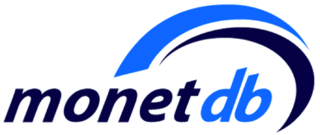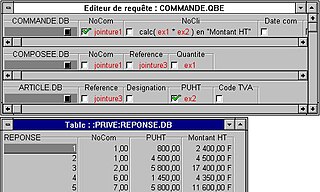
In computing, a database is an organized collection of data stored and accessed electronically. Small databases can be stored on a file system, while large databases are hosted on computer clusters or cloud storage. The design of databases spans formal techniques and practical considerations, including data modeling, efficient data representation and storage, query languages, security and privacy of sensitive data, and distributed computing issues, including supporting concurrent access and fault tolerance.

An object database or object-oriented database is a database management system in which information is represented in the form of objects as used in object-oriented programming. Object databases are different from relational databases which are table-oriented. Object–relational databases are a hybrid of both approaches.
A relational database is a database based on the relational model of data, as proposed by E. F. Codd in 1970. A system used to maintain relational databases is a relational database management system (RDBMS). Many relational database systems are equipped with the option of using the SQL for querying and maintaining the database.
SQL is a domain-specific language used in programming and designed for managing data held in a relational database management system (RDBMS), or for stream processing in a relational data stream management system (RDSMS). It is particularly useful in handling structured data, i.e. data incorporating relations among entities and variables.
Object–relational mapping in computer science is a programming technique for converting data between type systems using object-oriented programming languages. This creates, in effect, a "virtual object database" that can be used from within the programming language. There are both free and commercial packages available that perform object–relational mapping, although some programmers opt to construct their own ORM tools.

An object–relational database (ORD), or object–relational database management system (ORDBMS), is a database management system (DBMS) similar to a relational database, but with an object-oriented database model: objects, classes and inheritance are directly supported in database schemas and in the query language. In addition, just as with pure relational systems, it supports extension of the data model with custom data types and methods.
Query languages, data query languages or database query languages (DQLs) are computer languages used to make queries in databases and information systems. A well known example is the Structured Query Language (SQL).
Datalog is a declarative logic programming language. While it is syntactically a subset of Prolog, Datalog generally uses a bottom-up rather than top-down evaluation model. This difference yields significantly different behavior and properties from Prolog. It is often used as a query language for deductive databases. In recent years, Datalog has found new application in data integration, information extraction, networking, program analysis, security, cloud computing and machine learning.
Hibernate ORM is an object–relational mapping tool for the Java programming language. It provides a framework for mapping an object-oriented domain model to a relational database. Hibernate handles object–relational impedance mismatch problems by replacing direct, persistent database accesses with high-level object handling functions.

MonetDB is an open-source column-oriented relational database management system (RDBMS) originally developed at the Centrum Wiskunde & Informatica (CWI) in the Netherlands. It is designed to provide high performance on complex queries against large databases, such as combining tables with hundreds of columns and millions of rows. MonetDB has been applied in high-performance applications for online analytical processing, data mining, geographic information system (GIS), Resource Description Framework (RDF), text retrieval and sequence alignment processing.
A deductive database is a database system that can make deductions based on rules and facts stored in the (deductive) database. Datalog is the language typically used to specify facts, rules and queries in deductive databases. Deductive databases have grown out of the desire to combine logic programming with relational databases to construct systems that support a powerful formalism and are still fast and able to deal with very large datasets. Deductive databases are more expressive than relational databases but less expressive than logic programming systems. In recent years, deductive databases such as Datalog have found new application in data integration, information extraction, networking, program analysis, security, and cloud computing.
The object–relational impedance mismatch is a set of conceptual and technical difficulties that are often encountered when a relational database management system (RDBMS) is being served by an application program written in an object-oriented programming language or style, particularly because objects or class definitions must be mapped to database tables defined by a relational schema.

Query by Example (QBE) is a database query language for relational databases. It was devised by Moshé M. Zloof at IBM Research during the mid-1970s, in parallel to the development of SQL. It is the first graphical query language, using visual tables where the user would enter commands, example elements and conditions. Many graphical front-ends for databases use the ideas from QBE today. Originally limited only for the purpose of retrieving data, QBE was later extended to allow other operations, such as inserts, deletes and updates, as well as creation of temporary tables.
This is an alphabetical list of articles pertaining specifically to software engineering.

JADE is a proprietary object-oriented software development and deployment platform product from the New Zealand-based Jade Software Corporation, first released in 1996. It consists of the JADE programming language, Integrated development environment and debugger, integrated application server and object database management system.
Semmle Inc is a code-analysis platform with offices in San Francisco, Seattle, New York, Oxford, Valencia and Copenhagen. Semmle was acquired by GitHub on 18 September 2019 for an undisclosed amount. Semmle's LGTM technology automates code review, tracks developer contributions, and flags software security issues. The LGTM platform leverages the CodeQL query engine to perform semantic analysis on software code bases. GitHub aims to integrate Semmle technology to provide continuous vulnerability detection services. In November 2019, use of CodeQL was made free for research and open source. CodeQL either shares a direct pedigree with .QL (dot-que-ell), which derives from the Datalog family tree, or is an evolution of similar technology.
The Doctrine Project is a set of PHP libraries primarily focused on providing persistence services and related functionality. Its most commonly known projects are the object–relational mapper (ORM) and the database abstraction layer it is built on top of.

db4o was an embeddable open-source object database for Java and .NET developers. It was developed, commercially licensed and supported by Actian. In October 2014, Actian declined to continue to actively pursue and promote the commercial db4o product offering for new customers.
Apache Empire-db is a Java library that provides a high level object-oriented API for accessing relational database management systems (RDBMS) through JDBC. Apache Empire-db is open source and provided under the Apache License 2.0 from the Apache Software Foundation.
Java Database Connectivity (JDBC) is an application programming interface (API) for the programming language Java, which defines how a client may access a database. It is a Java-based data access technology used for Java database connectivity. It is part of the Java Standard Edition platform, from Oracle Corporation. It provides methods to query and update data in a database, and is oriented toward relational databases. A JDBC-to-ODBC bridge enables connections to any ODBC-accessible data source in the Java virtual machine (JVM) host environment.





